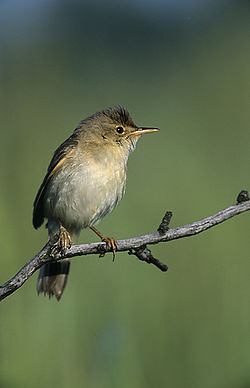Marsh warbler
| Marsh warbler | |
|---|---|
 |
|
| Scientific classification | |
| Kingdom: | Animalia |
| Phylum: | Chordata |
| Class: | Aves |
| Order: | Passeriformes |
| Superfamily: | Sylvioidea |
| Family: | Acrocephalidae |
| Genus: | Acrocephalus |
| Species: | A. palustris |
| Binomial name | |
|
Acrocephalus palustris (Bechstein, 1798) |
|
The marsh warbler (Acrocephalus palustris) is an Old World warbler currently classified in the family Acrocephalidae. It breeds in temperate Europe and western Asia and winters mainly in south east Africa. It is notable for incorporating striking imitations of a wide variety of other birds into its song.
The marsh warbler breeds in a variety of mostly damp habitats, but in Africa winters mainly in dry, well-vegetated areas. It is common over much of its breeding range and expanding its distribution in some areas. However, in Britain it is now virtually extinct as a breeding bird. This insectivorous warbler can be easily confused with several close relatives, but the imitative song of the male is highly distinctive.
This is a medium-sized warbler. It is very similar in appearance to several other acrocephaline warblers, such as the reed warbler which also occurs in wetlands and has a similar breeding range. The male's distinctive song is useful for identification, as no other member of the genus mimics other birds to any significant extent. The marsh warbler also tends to avoid the stands of pure reed which are the reed warbler's favoured habitat.
The species is monotypic, and there is no significant geographical variation. The sexes are alike in appearance. Hybridisation with both reed warbler and Blyth's reed warbler has been occasionally recorded.
The genus name Acrocephalus is from Ancient Greek akros, "highest", and kephale, "head". It is possible that Naumann and Naumann thought akros meant "sharp-pointed". The specific palustris is from Latin and means "marshy".
The marsh warbler breeds in the middle latitudes of Europe and western Asia, from the English Channel to about 70 degrees east. It mainly occupies areas with a continental climate, but breeds, or has bred, in Britain and northern France as well. it is principally a bird of the lowlands, but occurs at altitudes of up to 3000m in Georgia. In recent decades it has expanded its range to the north, with increasing numbers of birds breeding in Scandinavia and north-west Russia.
...
Wikipedia

